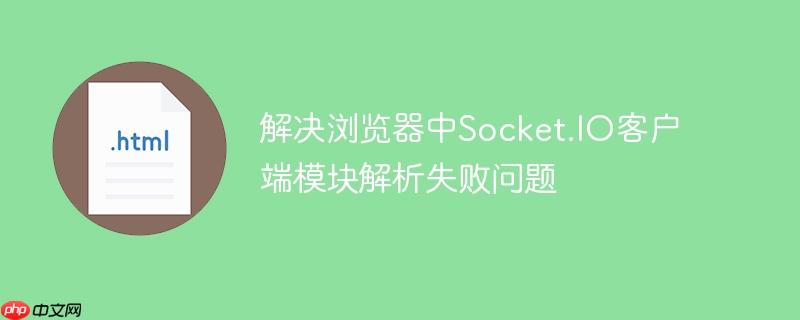
本文旨在解决在使用Socket.IO构建实时应用时,前端JavaScript代码中出现的“Failed to resolve module specifier ‘socket.io-client’”错误。核心内容是阐明该错误产生的原因——ES模块的裸模块说明符解析机制,并提供两种客户端集成Socket.IO的有效策略:一是利用服务器提供的全局io对象(推荐用于简单项目),二是结合构建工具使用ES模块化导入,确保客户端能够正确加载并初始化Socket.IO连接。
理解“Failed to resolve module specifier”错误
当您在浏览器环境中使用import { io } from “socket.io-client”;这样的语句,并且您的<script>标签带有type=”module”属性时,浏览器会尝试将您的JavaScript文件作为ES模块(ECMAScript Module)进行解析。ES模块的一个关键特性是其模块说明符(module specifier)的解析规则。
对于像”socket.io-client”这样的“裸模块说明符”(bare module specifier),浏览器默认无法直接解析。它期望模块说明符是以下形式之一:
- 相对路径: 如./module.js或../utils/helper.js。
- 绝对路径: 如/scripts/module.js。
- 完整URL: 如https://cdn.example.com/module.js。
由于”socket.io-client”不属于上述任何一种,浏览器无法确定从何处加载该模块,从而抛出“Failed to resolve module specifier”错误。解决此问题通常有两种主要策略,取决于您的项目需求和复杂度。
客户端Socket.IO集成策略
策略一:利用服务器提供的全局io对象(推荐用于简单项目)
Socket.IO服务器在启动时,会自动在/socket.io/socket.io.js路径下提供一个客户端库文件。这个文件被加载后,会在全局作用域中暴露一个io对象。这是在没有构建工具的情况下,集成Socket.IO客户端最简单、最直接的方式。
核心思想:
- 在HTML中通过标准<script>标签加载服务器提供的socket.io.js。
- 确保您的客户端脚本(如client.js)不使用type=”module”属性。
- 在客户端脚本中直接访问全局io对象。
示例代码调整:
首先,修改您的HTML文件(index.html):
<html lang="en"> <head> <meta charset="UTF-8"> <meta http-equiv="X-UA-Compatible" content="IE=edge"> <meta name="viewport" content="width=device-width, initial-scale=1.0"> <title>pro-chat realdtime socakat ios</title> <link rel="stylesheet" href="style.css"> </head> <body> <nav> <img class="logo" src="chat.jpg" alt=""> </nav> <div class="container"> <div class="message right">Aniket:kase ho bhai</div> <div class="message left">Raju:thik hai bhai</div> </div> <div class="send"> <form action="#" id="send-container" > <input type="text" name="messageInp" id="messageInp"> <button class="btn" type="submit">Send</button> </form> </div> <!-- 1. 首先加载服务器提供的 socket.io 客户端库 --> <script src="/socket.io/socket.io.js"></script> <!-- 2. 移除 type="module" 属性,使其成为一个普通脚本 --> <script src="js/client.js"></script> </body> </html>
接着,修改您的客户端JavaScript文件(js/client.js):
// 移除 ES 模块导入语句,因为 io 已经通过全局脚本加载 // import { io } from "socket.io-client"; // 直接访问全局的 io 对象 const socket = io(); const form = document.getElementById('send-container'); const messageInput = document.getElementById('messageInp'); const messageContainer = document.querySelector(".container"); const name = prompt("Enter your name to join:"); const append = (message, position) => { const messageElement = document.createElement('div'); messageElement.innerText = message; messageElement.classList.add('message'); messageElement.classList.add(position); messageContainer.append(messageElement); }; form.addEventListener('submit', (e) => { e.preventDefault(); const message = messageInput.value; append(`You: ${message}`, 'right'); socket.emit('send', message); messageInput.value = ''; }); socket.emit('new-user-joined', name); socket.on('user-joined', name => { append(`${name} joined the chat`, 'right'); }); socket.on('receiv', data => { // 注意:这里原文是 'receiv',可能是 'receive' 的拼写错误 append(`${data.name}:${data.message}`, 'left'); });
通过以上修改,client.js将作为一个标准脚本运行,能够访问由/socket.io/socket.io.js在全局作用域中暴露的io对象,从而解决模块解析错误。
策略二:使用ES Modules与构建工具(适用于现代前端项目)
如果您正在构建一个复杂的现代前端应用,并希望充分利用ES模块的优势,那么结合构建工具(如Webpack, Rollup, Parcel, Vite等)是更合适的选择。
核心思想:
- 通过npm安装socket.io-client。
- 在您的客户端代码中使用import { io } from “socket.io-client”;。
- 配置构建工具来处理模块解析和打包,将node_modules中的socket.io-client打包到您的前端bundle中。
- HTML中的客户端脚本仍然使用type=”module”。
步骤概述:
- 安装客户端库:
npm install socket.io-client
- 客户端JavaScript(js/client.js):
import { io } from "socket.io-client"; // 此处保持不变 const socket = io(); // ... 其他客户端逻辑 - HTML文件(index.html):
- 移除<script src=”/socket.io/socket.io.js”></script>,因为构建工具会处理socket.io-client的引入。
- 确保您的客户端脚本仍然带有type=”module”属性,并指向构建工具输出的打包文件(例如,dist/bundle.js)。
<!-- 移除此行:<script src="/socket.io/socket.io.js"></script> --> <script src="dist/bundle.js" type="module"></script> <!-- 假设构建工具输出到 dist/bundle.js -->
- 配置构建工具: 根据您选择的构建工具,进行相应的配置,使其能够解析node_modules中的模块并打包。
这种方法更适用于需要模块化、代码优化和复杂依赖管理的大型前端项目。
服务器端代码(参考)
为了提供完整的上下文,以下是您的服务器端代码,它负责启动Socket.IO服务器并处理连接:
const app = require('express')(); const server = require('http').createServer(app); const io = require("socket.io")(server, { cors: { origin: ["https://example.com", "https://dev.example.com"], allowedHeaders: ["my-custom-header"], credentials: true } }); // app.get('/', (req, res) => { // res.sendFile(__dirname + '/index.html'); // }); // 如果您想直接通过Express提供 index.html,可以启用此行 server.listen(3000, () => { console.log('listening on *:3000...'); }); const users = {}; // 用于存储用户信息的对象 io.on('connection', socket => { console.log("Connection to server", socket.id); // 使用 socket.id 更清晰 socket.on('new-user-joined', name => { users[socket.id] = name; socket.broadcast.emit('user-joined', name); // 广播给除发送者外的所有客户端 }); socket.on('send', message => { socket.broadcast.emit('recive', { message: message, name: users[socket.id] }); // 广播消息 }); socket.on('disconnect', () => { // 处理用户断开连接 if (users[socket.id]) { const disconnectedUserName = users[socket.id]; delete users[socket.id]; socket.broadcast.emit('user-left', disconnectedUserName); console.log(`${disconnectedUserName} disconnected.`); } }); });
注意事项:
- 在服务器端代码中,consol.log应修正为console.log。
- socket.on(‘receiv’, …) 客户端事件监听器和 socket.broadcast.emit(‘recive’, …) 服务器端事件发送器中的事件名建议统一为 receive 以避免混淆和潜在错误。
- 添加了disconnect事件处理,以更好地管理用户状态。
总结
“Failed to resolve module specifier”错误是ES模块在浏览器中解析裸模块说明符时的常见问题。对于简单的Socket.IO应用,最直接的解决方案是利用Socket.IO服务器提供的全局客户端库,并确保您的客户端脚本不使用type=”module”。对于更复杂的项目,结合构建工具进行模块打包是标准实践。理解这两种集成策略及其背后的原理,能帮助您更高效地构建实时Web应用。
以上就是解决css javascript java html js 前端 node go 浏览器 app edge 工具 ssl JavaScript ecmascript html npm webpack JS console 对象 作用域 事件 https


